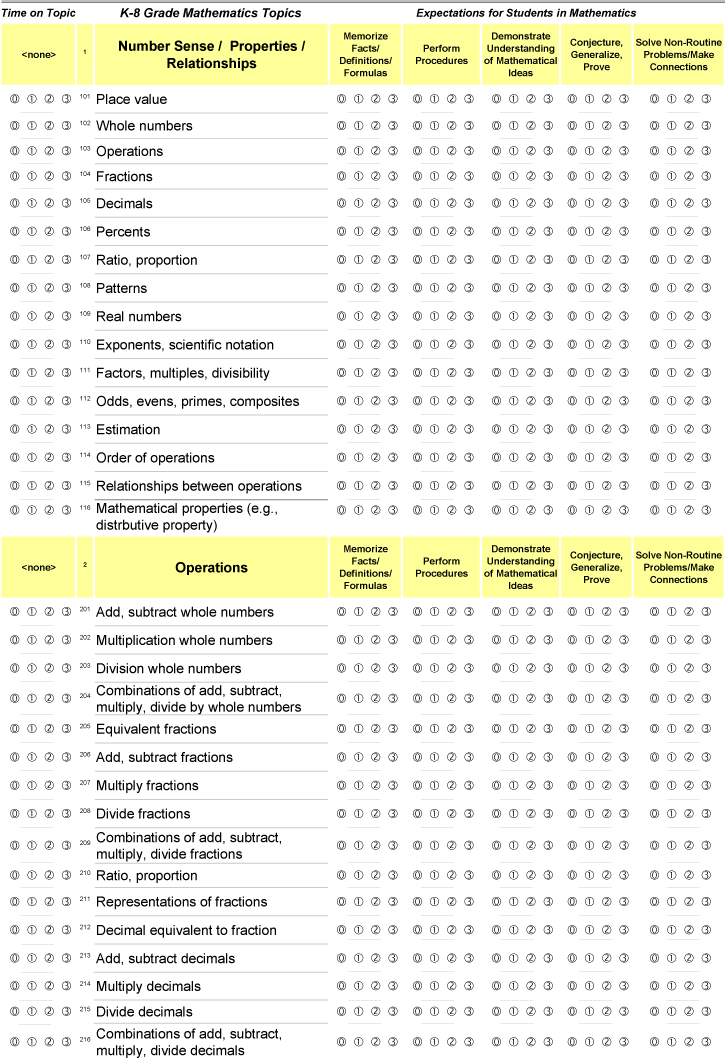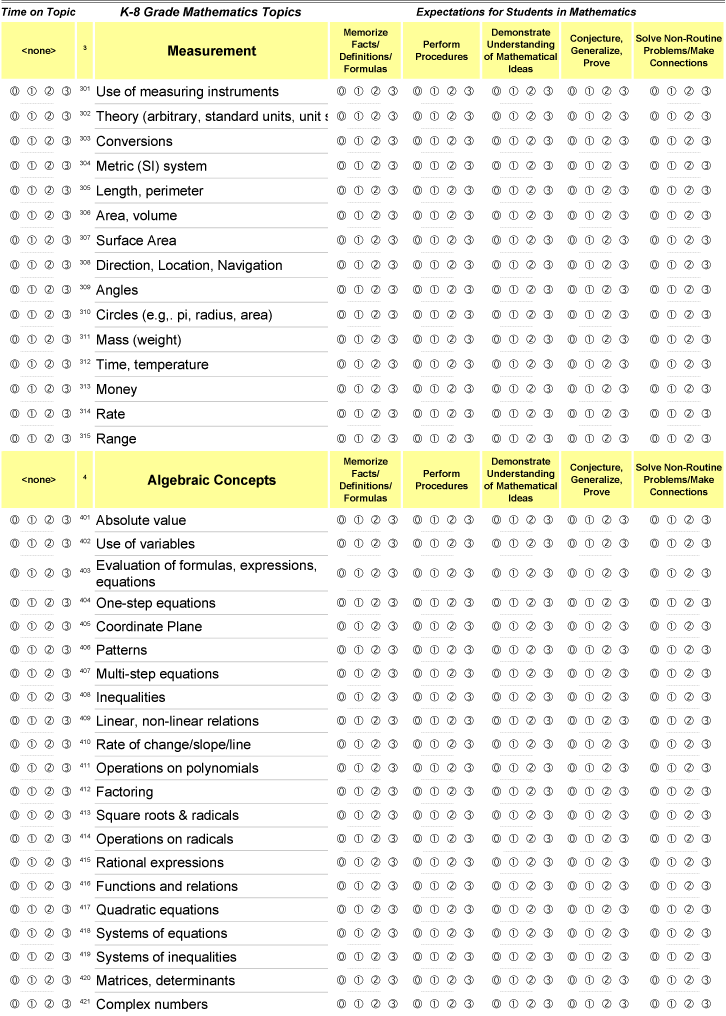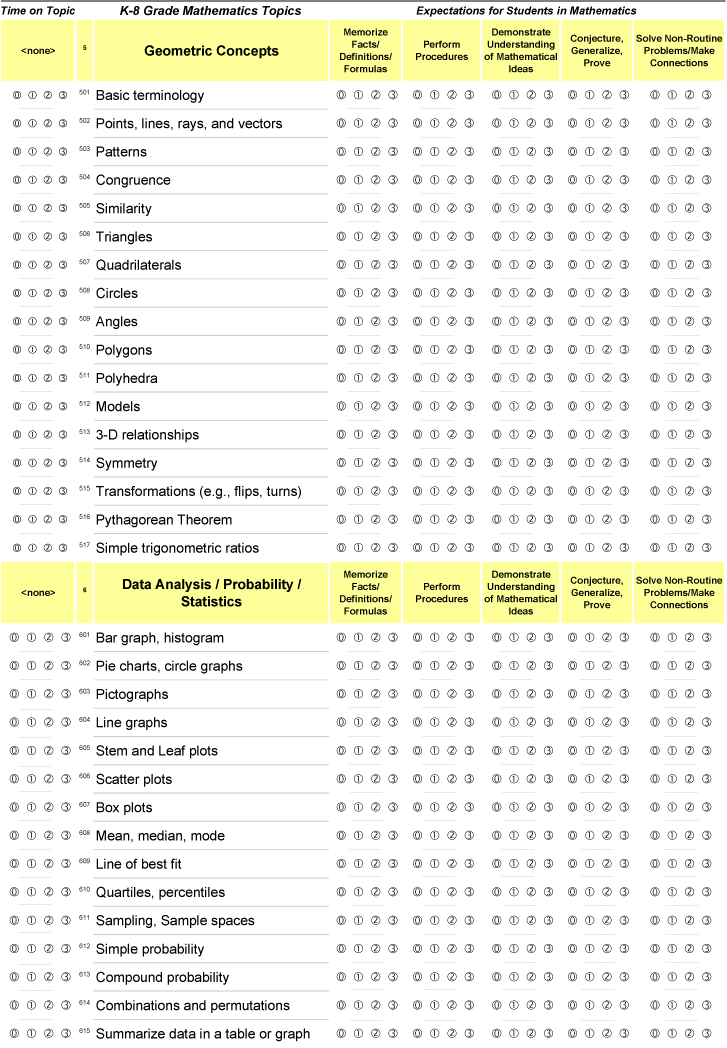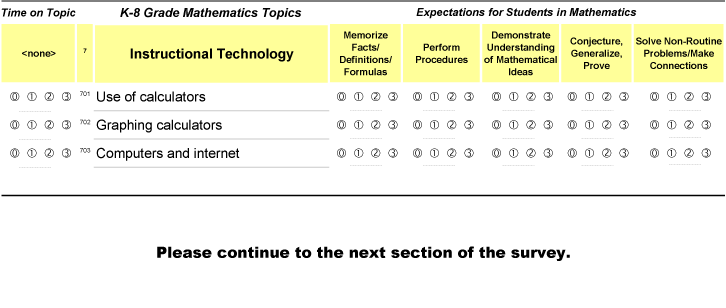Teacher/Faculty Surveys
Instrument 16: Teacher Survey For Grades K-8 Mathematics
Project: Surveys of Enacted Curriculum
Council of Chief State School Officers
Funding Source: NSF: EHR
Purpose: To provide comparative information on mathematics instruction
Administered To: K-8 teachers whose school districts are participating in the Mathematics and Science Partnership Program
Topics Covered:
- Implementation Activities: content, method, activities, curriculum/materials, equipment/technology, professional development activities, collaboration
- Learning Environment: method, pedagogy
- Lesson/Curriculum Plan: learning environment, methods, content, activities, materials
- Self Assessment (Teacher): application of instructional methods, implementation activities
Format/Length: 528 closed-ended items
Council of Chief State School Officers
Wisconsin Center for Education Research
SURVEYS OF ENACTED CURRICULUM
Teacher Survey
For
Grades K-8
Mathematics
Thank you for agreeing to participate in this survey on science and mathematics instruction. The enclosed survey is part of a collaborative effort to provide education policymakers, administrators, and most importantly, teachers like yourself with comparative information about mathematics and science instruction in districts participating in the Mathematics and Science Partnership Program. To learn more about the surveys of enacted curriculum and their use in other projects, please visit the project website; http://www.ccsso.org/sec.html
Your participation in this survey is voluntary. If you choose to participate, all of your responses will be kept confidential. No one outside of the research team will have access to your responses, nor will any individual responses be shared with staff in your school, district or state. No individuals will be identified in any of the reports. The questionnaire poses no risk to you and there is no penalty for refusal to participate. You may withdraw from the study simply by returning the questionnaire without completing it, without penalty or loss of services or benefits to which you would be otherwise entitled.
If you have any questions regarding your rights as a research participant, please contact the University of Wisconsin-Madison School of Education's Human Subjects Committee office at (608) 262-2463.
A joint project of the Council of Chief State School Officers, the American Institutes for Research and the Wisconsin Center for
Education Research, with funding support from the National mathematics Foundation.
The following pages request information regarding students in the target mathematics class for the 2002-2003 school year (last school year).
Please read each question and the possible responses carefully, and then mark your response by filling in the appropriate circle in the response section. A pen or pencil may be used to complete the survey.
| 4 |
Indicate the grade level of the majority of students in the target class. |

K |

1 |

2 |

3 |

4 |

5 |

6 |

7 |

8 |

9 |

10 |

11 |

12 |
| |
|
|
|
|
|
|
|
|
|
|
|
|
|
|
| 5 |
How many students are in the target class? |
|
 |
10 or less |
|
|
 |
21 to 25 |
| |
|
 |
11 to 15 |
|
|
 |
26 to 30 |
| |
|
 |
16 to 20 |
|
|
 |
31 or more |
| |
|
|
|
|
|
|
|
|
|
|
|
|
|
|
| 6 |
What percentage of the students in the target class are female? (Estimate to the nearest ten percent.) |
|
|
|
|
|
|
|
|
|
|
|
 |
|
| |
Less than 10 |
10 |
20 |
30 |
40 |
50 |
60 |
70 |
80 |
90+ % |
| |
|
|
|
|
|
|
|
|
|
|
|
|
|
|
| 7 |
What percentage of the students in the target class are not Caucasian? (Estimate to the nearest ten percent.) |
|
|
|
|
|
|
|
|
|
|
|
 |
|
| |
Less than 10 |
10 |
20 |
30 |
40 |
50 |
60 |
70 |
80 |
90+ % |
| |
|
|
|
|
|
|
|
|
|
|
|
|
|
|
| 8 |
During a typical week,
approximately how many hours will the target class spend in mathematics instruction? |
|
 |
 |
 |
 |
 |
 |
 |
 |
 |
 |
|
|
(Number of instructional hours) |
|
|
| |
|
|
|
|
|
|
|
|
|
|
|
|
|
|
| 9 |
What is the average length of each class period for this targeted mathematics class? |
|
 |
Not applicable |
 |
51 to 60 minutes |
 |
30 to 40 minutes |
 |
61 to 90 minutes |
 |
41 to 50 minutes |
 |
91 to 120 minutes |
 |
Varies due to block scheduling or integrated instruction |
|
|
|
|
|
|
| |
|
|
|
|
|
|
|
|
|
|
|
|
|
|
| 10 |
How many weeks total will the target mathematics class/course meet for this school year? |
|
|
|
|
Total # weeks = |
1 to 12 |
13 to 24 |
25 to 36 |
| |
|
|
|
|
|
|
|
|
|
|
|
|
|
|
| 11 |
Estimate the achievement level of the majority of students in the target class, based on national standards. |
|
 |
High Achievement Levels |
|
|
|
 |
Average Achievement Levels |
 |
Low Achievement Levels |
 |
Mixed Levels of Achievement |
| |
|
|
|
|
|
|
|
|
|
|
|
|
|
|
| 12 |
What percentage of students in the target class are Limited English Proficient (LEP)? (Estimate to the nearest ten percent.) |
|
|
|
|
|
|
|
|
|
|
|
 |
|
| |
Less than 10 |
10 |
20 |
30 |
40 |
50 |
60 |
70 |
80 |
90+ % |
| |
|
|
|
|
|
|
|
|
|
|
|
|
|
|
| 13 |
What is considered most in scheduling students into this class? |
|
 |
Ability or Achievement |
 |
Parent Request |
 |
Limited English Proficiency |
 |
No one factor more than another |
 |
Teacher Recommendation |
 |
Student selects |
| |
|
|
|
|
|
|
|
|
|
|
|
|
|
|
| |
|
|
|
|
|
|
|
|
|
|
|
|
|
|
Please read the instructions on the next two pages carefully before proceeding.
|
Council of Chief State School Officers
Wisconsin Center
for Education Research
Instructional Content
For
Grades K-8
Mathematics
The content matrix that follows contains lists of discrete topics associated with
mathematics instruction. The categories and the level of specificity are intended to gather
information about content across a wide variety of programs. It is not intended to
reflect any recommended or prescribed content for the grade level and may or may not be
reflective of your local curriculum. The following pages request information
regarding topic coverage and your expectations for students in the target mathematics class
for the 2002-2003 school year (last school year).
Step 1: Indicate topics not covered in this class
Begin by reviewing the entire list of topics identified in the topics column of
each table, noting how topics are grouped. After reviewing each topic within a given
grouping, if none of the topics listed within that group receive any instructional coverage,
circle the "<none>" in the "Time on Topic" column for that group. For any individual topic
which is not covered in this mathematics class, fill in the circled "zero" in the "Time on Topic"
column. (Not necessary for those groups with "<none>" circled.) Any topics or topic group
so identified will not require further response. [Note, for example, that the class
described in the example below did not cover any topics under "Instructional Technology"
and so "<none>" is circled.]
Step 2: Indicate the amount of time spent on each topic covered in this class
Examine the list of topics a second time. This time note the amount of coverage
devoted to each topic by filling in the appropriately numbered circle in the "Time on Topic"
column based upon the following codes:
| |
0 = None, not covered |
|
| |
1 = Slight coverage |
(less than one class/lesson) |
| |
2 = Moderate coverage |
(one to five classes/lessons) |
| |
3 = Sustained coverage |
(more than five classes/lessons) |
Step 3: Indicate relative emphasis of each student expectation for every topic taught
The final step in completing this section of the survey concerns your expectations
for what students should know and be able to do. For each topic area, please provide
information about the relative amount of instructional time spent on work designed to help
students reach each of the listed expectations by filling in the appropriately numbered
circle using the response codes listed below. (Note: To the left of each content sheet,
you will find a list of descriptors for each of the five expectations for students.)
| |
0 = No emphasis |
(Not an expectation for this topic.) |
| |
1 = Slight emphasis |
(Accounts for less than 25% of the time spent on this topic.) |
| |
2 = Moderate emphasis |
(Accounts for 25% to 33% of the time spent on this topic.) |
| |
3 = Sustained emphasis |
(Accounts for more than 33% of the time spent on this topic.) |
| |
|
|
Note: |
A code of "3" should typically be given for only one,
and no more than two expectation categories within any given topic. No expectation
codes should be filled-in for those topics for which no coverage is provided
(i.e., circled "0" or "<none>"). |

Expectations for Students in Mathematics
| |
|
|
|
Memorize Facts/ Definitions/
Formulas
|
Conjecture/Generalize/Prove
|
| |
Recite basic mathematics facts
Recall mathematics terms and definitions
Recall formulas and computational procedures |
|
Determine the truth of a mathematical pattern or proposition
Write formal or informal proofs
Recognize, generate or create patterns
Find a mathematical rule to generate a pattern or number sequence
Make and investigate mathematical conjectures
Identify faulty arguments or misrepresentations of data
Reason inductively or deductively
|
Perform Procedures
|
| |
Use numbers to count, order, denote
Do computational procedures or algorithms
Follow procedures/instructions
Solve equations/formulas/routine word problems
Organize or display data
Read or produce graphs and tables
Execute geometric constructions
|
Demonstrate Understanding
of Mathematical Ideas
|
Solve Non-routine Problems/
Make Connections
|
| |
Communicate mathematical ideas
Use representations to model mathematical ideas
Explain findings and results from data analysis strategies
Develop/explain relationships between concepts
Show or explain relationships between models, diagrams, and/or other representations
|
|
Apply and adapt a variety of appropriate strategies to solve non-routine problems
Apply mathematics in contexts outside of mathematics
Analyze data, recognize patterns
Synthesize content and ideas from several sources |
| |
| |
|
| |
|
|
|
Response Codes
Time on Topic
|
Response Codes
Expectations for Students
|
| |
0 = |
None
(Not Covered) |
|
0 = |
No emphasis
(Not a performance goal for this topic) |
| |
1 = |
Slight coverage
(Less than one class/lesson) |
|
1 = |
Slight emphasis
(Less than 25% of time on this topic) |
| |
2 = |
Moderate coverage
(One to five classes/lessons) |
|
2 = |
Moderate emphasis
(25% to 33% of time on this topic) |
| |
3 = |
Sustained coverage
(More than five classes/lessons) |
|
3 = |
Sustained emphasis
(More than 33% of time on this topic) |
| |
|
|
|
|
|




|
 |















